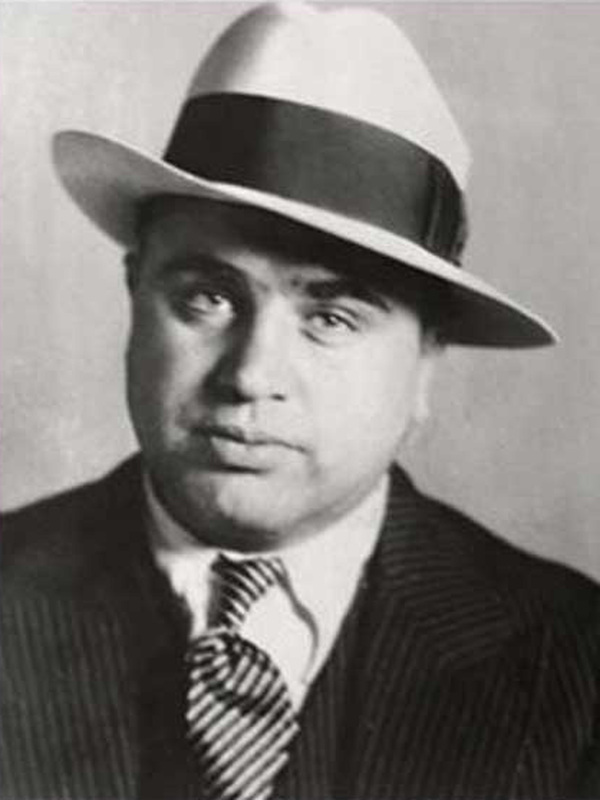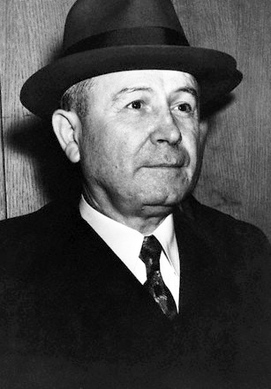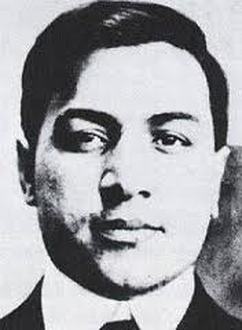Al Capone
Big, friendly ... dangerous
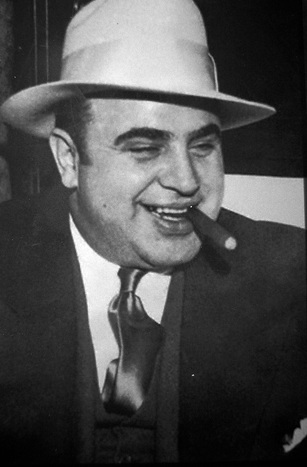
Capone liked people and they liked him.
He was big, flamboyant and impossible to miss. Just under six feet and over 250 pounds, Alphonse Gabriel Capone, with his cigar and diamond pinky ring, was charismatic, warm, generous ... and had a quick and violent temper. He had little formal education and wasn’t very articulate, but he was outgoing and was liked by the public.
He confused flamboyance with elegance and his suits, while costly and tailor-made, consisted mostly of purple, electric blue or yellow topped by pearl-gray fedoras with wide black bands. His shirts were custom-made of silk and his ties were handmade and accented with diamond stickpins. A big tipper and an easy touch for anyone looking for a handout, Capone had a good sense of humor and was often quoted in the newspapers.
He took exception to being called a gangster or hoodlum and said he was just a businessman who supplied the public with a product it wanted. He often said he never forced anyone to buy anything from him, that it was the public who sought out his product.
Those who knew him best - his family - said the public myth and the private man were entirely different. Behind closed doors, they said, he was warm, gentle and loving. They said he often regretted his path in life and constantly warned others about following his lead. True? No one will ever really know.
But one thing is certain. Capone ruled Chicago with an iron fist during the bloody beer wars of the Prohibition era from the early 1920s to 1931 when he was convicted of income tax evasion and sentenced to a lengthy term in federal prison. His empire, while build on smuggling and bootleg liquor, also included other activities such as prostitution, murder, bribery, loansharking and extortion.
He confused flamboyance with elegance and his suits, while costly and tailor-made, consisted mostly of purple, electric blue or yellow topped by pearl-gray fedoras with wide black bands. His shirts were custom-made of silk and his ties were handmade and accented with diamond stickpins. A big tipper and an easy touch for anyone looking for a handout, Capone had a good sense of humor and was often quoted in the newspapers.
He took exception to being called a gangster or hoodlum and said he was just a businessman who supplied the public with a product it wanted. He often said he never forced anyone to buy anything from him, that it was the public who sought out his product.
Those who knew him best - his family - said the public myth and the private man were entirely different. Behind closed doors, they said, he was warm, gentle and loving. They said he often regretted his path in life and constantly warned others about following his lead. True? No one will ever really know.
But one thing is certain. Capone ruled Chicago with an iron fist during the bloody beer wars of the Prohibition era from the early 1920s to 1931 when he was convicted of income tax evasion and sentenced to a lengthy term in federal prison. His empire, while build on smuggling and bootleg liquor, also included other activities such as prostitution, murder, bribery, loansharking and extortion.
Growing up in Brooklyn
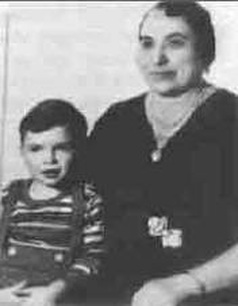
A young Capone and his mother.
Capone was born in Brooklyn on Jan. 17, 1899, to Italian immigrants Gabriele and Teresina Capone . His father was a barber from Castellammare di Stabia, a town about 16 miles south of Naples. His mother was a seamstress and the daughter of Angelo Raiola from Angri, a town in the province of Salerno. The couple had nine children: Alphonse, James (who would become a decorated lawman known as Richard "Two-Gun" Hart), Raffaele (known as "Bottles," who took charge of his brother’s beverage industry), Salvatore ("Frank"), John, Albert, Matthew, Rose and Mafalda.
The family immigrated to the United States in 1893 and settled at 95 Navy St., in the Navy Yard section of Brooklyn. One of their neighbors was Frank Nitti, a close friend of Capone's older brothers. Nitti would eventually settle in Chicago and would go on to become one of Capone's most trusted aides.
Capone's father worked at a nearby barber shop at 29 Park Avenue. When Capone was 11, the family moved to 38 Garfield Place in Brooklyn’s Park Slope.
Records indicate Capone showed promise as a student, but had trouble with the rules at his strict Catholic school and dropped out at the age of 14, after striking a female teacher in the face. He worked at various odd jobs around Brooklyn, including a candy store and a bowling alley.
The family immigrated to the United States in 1893 and settled at 95 Navy St., in the Navy Yard section of Brooklyn. One of their neighbors was Frank Nitti, a close friend of Capone's older brothers. Nitti would eventually settle in Chicago and would go on to become one of Capone's most trusted aides.
Capone's father worked at a nearby barber shop at 29 Park Avenue. When Capone was 11, the family moved to 38 Garfield Place in Brooklyn’s Park Slope.
Records indicate Capone showed promise as a student, but had trouble with the rules at his strict Catholic school and dropped out at the age of 14, after striking a female teacher in the face. He worked at various odd jobs around Brooklyn, including a candy store and a bowling alley.
Accepted by Yale and Harvard
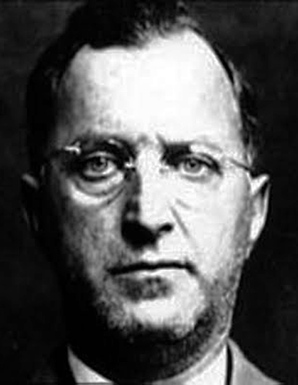
Frank Gallucio left a lasting impression.
After brief associations with small-time gangs that included the Junior Forty Thieves and the Bowery Boys, Capone joined the Brooklyn Rippers and later "Pappa" Johnny Torrio's James Street Boys before eventually associating with the powerful Five Points Gang, which was based in Lower Manhattan and was considered the "farm league" for organized crime.
It was during his James Street Boys and Five Points Gang period that Capone came to the attetnion of Torrio, who would go on to mentor him and play a major role in Capone’s life. Capone’s "official" job was as a waiter and bouncer, working for Frankie Yale (Francesco Ioele), a gangster and the owner of a Coney Island dance hall and saloon called the Harvard Inn. Despite it’s classy-sounding name, the Harvard Inn catered to a tough crowd and drunken brawls were common. Yale would go on to befriend Capone, mentor him and eventually become one of his victims.
It was at the Harvard Inn that Capone, at 19, received the scars that gave him the nickname "Scarface." According to a widely believed story, Capone approached a young woman in the club and loudly told her, "Honey, you have a beautiful ass, and I mean that as a compliment, really." Sitting with the woman was her brother, Frank Gallucio, a smalltime hood who immediately punched Capone, knocking him backward. Capone quickly regained his footing and as he came toward the much smaller man, Gallucio produced a knife with a four-inch blade and rapidly slashed Capone’s face three times on the left side. One cut ran four inches along the cheek, a second followed the jaw line for two inches. The third, not as visible as the others, ran from just below his left ear down along his neck. The scars would eventually heal to a milky white color that would stand out against Capone’s deep olive skin tone.
For the rest of his life, Capone remained sensitive about the scars and hid them. On the rare occasion he spoke of them, he said they were war wounds, and he never knowingly allowed his left side to be photographed. He even resorted to using makeup to help hide the scars.
Capone vowed revenge against Gallucio, who immediately sought the protection of a small-time gangster named Albert Altierri who, in turn, went to an up and coming New York gangster named Salvatore Lucania for help. Lucania, who would later become the most powerful gangster in U.S. history and would be better known as Charles "Lucky" Luciano, ordered a "sit down" at the Harvard Inn to resolve the matter. Present, according to crime historians, were Capone, Yale, Luciano, Altierri, Gallucio and at least two others. After hearing everyone’s story, Luciano sided with Gallucio, noting he was right to defend his sister’s honor and told Capone he had been out of order and warned him not to take revenge on Gallucio.
Capone was not happy, but he learned two valuable lessons that night: to keep his temper and the power of the bosses to influence the daily lives of those in their organizations. They were lessons he used wisely in the years to come when he ruled Chicago. As to Gallucio, he was never more than a small-time player, but to show there were no hard feelings, years later, when Capone could have taken revenge without fear, he hired Gallucio as an errand-runner. (As to Capone’s "war wounds," he never served and his famous, often reproduced military papers actually belonged to another Al Capone, a butcher in New Jersey.)
As to his nickname "Scarface," that was strictly from the movies and the press. He was always known to his friends and associates as Al or boss. His closest friends called him "Snorky," a 1920’s slang term that meant sharp and well-dressed. He liked that name.
NEXT
It was during his James Street Boys and Five Points Gang period that Capone came to the attetnion of Torrio, who would go on to mentor him and play a major role in Capone’s life. Capone’s "official" job was as a waiter and bouncer, working for Frankie Yale (Francesco Ioele), a gangster and the owner of a Coney Island dance hall and saloon called the Harvard Inn. Despite it’s classy-sounding name, the Harvard Inn catered to a tough crowd and drunken brawls were common. Yale would go on to befriend Capone, mentor him and eventually become one of his victims.
It was at the Harvard Inn that Capone, at 19, received the scars that gave him the nickname "Scarface." According to a widely believed story, Capone approached a young woman in the club and loudly told her, "Honey, you have a beautiful ass, and I mean that as a compliment, really." Sitting with the woman was her brother, Frank Gallucio, a smalltime hood who immediately punched Capone, knocking him backward. Capone quickly regained his footing and as he came toward the much smaller man, Gallucio produced a knife with a four-inch blade and rapidly slashed Capone’s face three times on the left side. One cut ran four inches along the cheek, a second followed the jaw line for two inches. The third, not as visible as the others, ran from just below his left ear down along his neck. The scars would eventually heal to a milky white color that would stand out against Capone’s deep olive skin tone.
For the rest of his life, Capone remained sensitive about the scars and hid them. On the rare occasion he spoke of them, he said they were war wounds, and he never knowingly allowed his left side to be photographed. He even resorted to using makeup to help hide the scars.
Capone vowed revenge against Gallucio, who immediately sought the protection of a small-time gangster named Albert Altierri who, in turn, went to an up and coming New York gangster named Salvatore Lucania for help. Lucania, who would later become the most powerful gangster in U.S. history and would be better known as Charles "Lucky" Luciano, ordered a "sit down" at the Harvard Inn to resolve the matter. Present, according to crime historians, were Capone, Yale, Luciano, Altierri, Gallucio and at least two others. After hearing everyone’s story, Luciano sided with Gallucio, noting he was right to defend his sister’s honor and told Capone he had been out of order and warned him not to take revenge on Gallucio.
Capone was not happy, but he learned two valuable lessons that night: to keep his temper and the power of the bosses to influence the daily lives of those in their organizations. They were lessons he used wisely in the years to come when he ruled Chicago. As to Gallucio, he was never more than a small-time player, but to show there were no hard feelings, years later, when Capone could have taken revenge without fear, he hired Gallucio as an errand-runner. (As to Capone’s "war wounds," he never served and his famous, often reproduced military papers actually belonged to another Al Capone, a butcher in New Jersey.)
As to his nickname "Scarface," that was strictly from the movies and the press. He was always known to his friends and associates as Al or boss. His closest friends called him "Snorky," a 1920’s slang term that meant sharp and well-dressed. He liked that name.
NEXT
